ABS MITSUBISHI LANCER EVOLUTION 2014 10.G Owners Manual
[x] Cancel search | Manufacturer: MITSUBISHI, Model Year: 2014, Model line: LANCER EVOLUTION, Model: MITSUBISHI LANCER EVOLUTION 2014 10.GPages: 338, PDF Size: 40.99 MB
Page 52 of 338
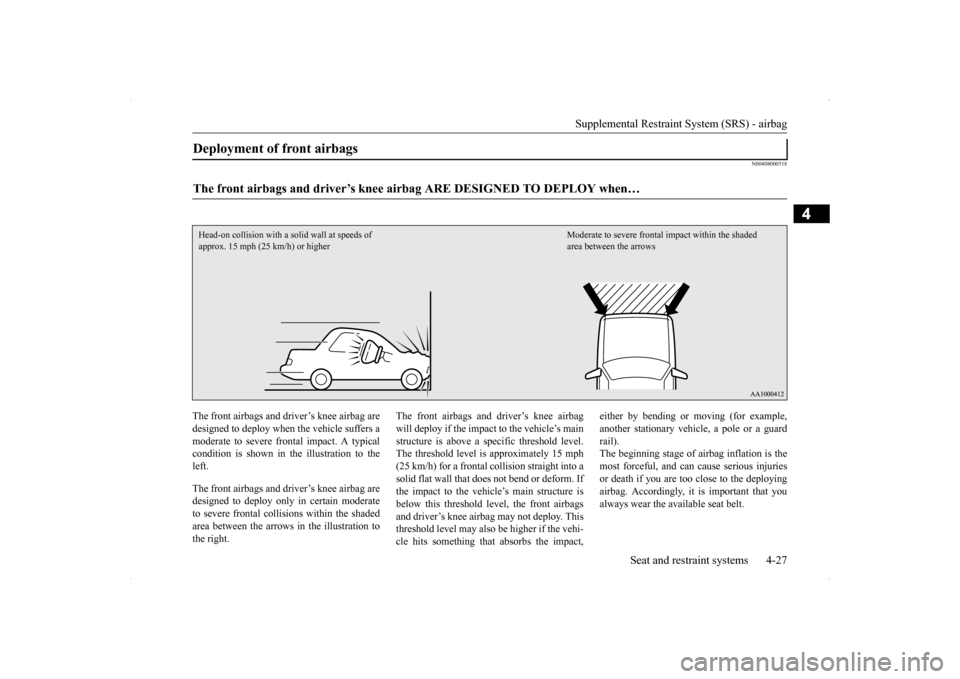
Supplemental Restraint System (SRS) - airbag
Seat and restraint systems 4-27
4
N00408000518
The front airbags and driver’s knee airbag are designed to deploy when the vehicle suffers amoderate to severe frontal impact. A typical condition is shown in th
e illustration to the
left. The front airbags and driver’s knee airbag are designed to deploy only in certain moderate to severe frontal collisions within the shaded area between the arrows in the illustration tothe right.
The front airbags and driver’s knee airbag will deploy if the impact to the vehicle’s mainstructure is above a specific threshold level. The threshold level is approximately 15 mph (25 km/h) for a frontal collision straight into asolid flat wall that does not bend or deform. If the impact to the vehicle’s main structure is below this threshold level, the front airbagsand driver’s knee airbag may not deploy. This threshold level may also be higher if the vehi- cle hits something that absorbs the impact,
either by bending or moving (for example, another stationary vehicle, a pole or a guardrail). The beginning stage of airbag inflation is the most forceful, and can cause serious injuriesor death if you are too close to the deploying airbag. Accordingly, it is important that you always wear the available seat belt.
Deployment of front airbags The front airbags and driver’s knee airb
ag ARE DESIGNED TO DEPLOY when…
Head-on collision with a so
lid wall at speeds of
approx. 15 mph (25 km/h) or higher
Moderate to severe frontal
impact within the shaded
area between the arrows
BK0200800US.bo
ok 27 ページ 2013年2月14日 木曜日 午後2時28分
Page 53 of 338
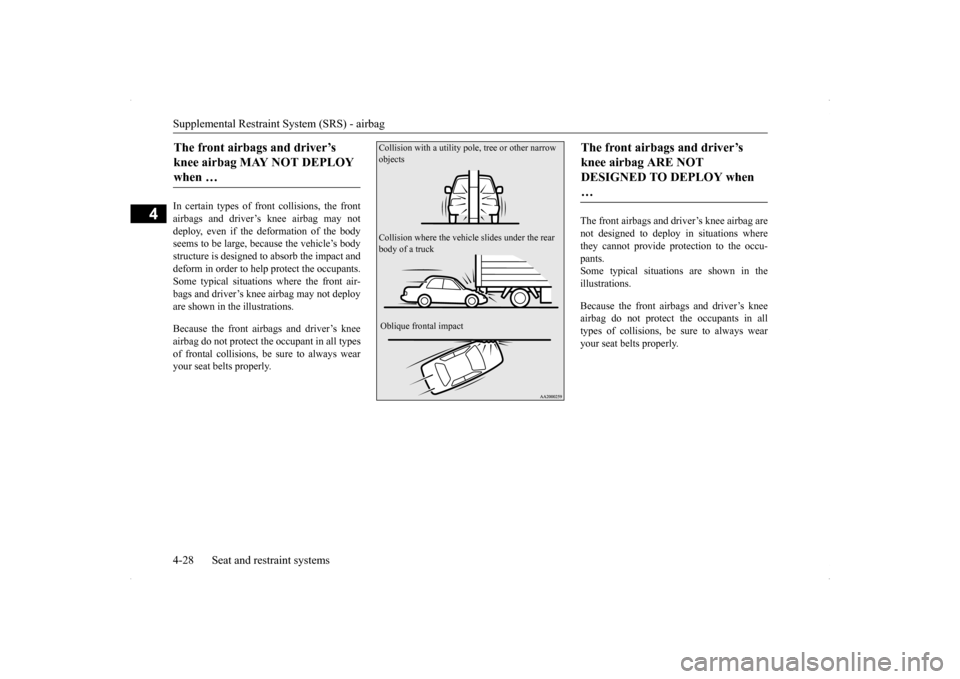
Supplemental Restraint System (SRS) - airbag 4-28 Seat and restraint systems
4
In certain types of fr
ont collisions, the front
airbags and driver’s knee airbag may not deploy, even if the deformation of the body seems to be large, because the vehicle’s bodystructure is designed to absorb the impact and deform in order to help protect the occupants. Some typical situations where the front air-bags and driver’s knee airbag may not deployare shown in the illustrations. Because the front airbags and driver’s knee airbag do not protect the occupant in all types of frontal collisions, be sure to always wearyour seat belts properly.
The front airbags and driver’s knee airbag are not designed to deploy in situations wherethey cannot provide protection to the occu- pants. Some typical situations are shown in theillustrations. Because the front airbags and driver’s knee airbag do not protect the occupants in all types of collisions, be sure to always wear your seat belts properly.
The front airbags and driver’s knee airbag MAY NOT DEPLOY when …
Collision with a utility pole
, tree or other narrow
objects Collision where the vehicle
slides under the rear
body of a truck Oblique frontal impact
The front airbags and driver’s knee airbag ARE NOT DESIGNED TO DEPLOY when …
BK0200800US.bo
ok 28 ページ 2013年2月14日 木曜日 午後2時28分
Page 58 of 338
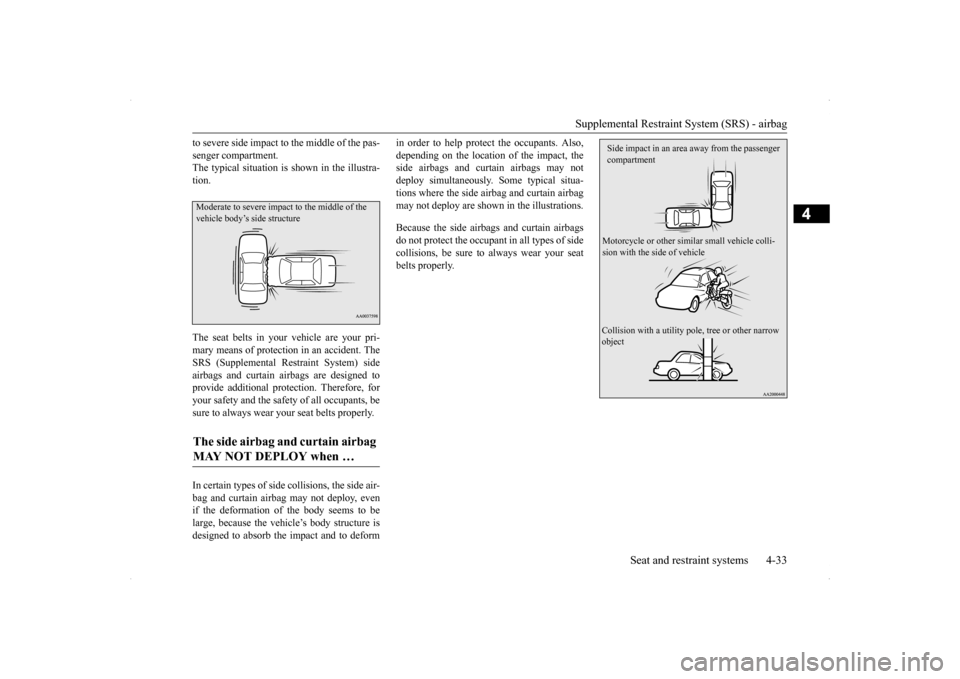
Supplemental Restraint System (SRS) - airbag
Seat and restraint systems 4-33
4
to severe side impact to the middle of the pas- senger compartment. The typical situation is shown in the illustra- tion. The seat belts in your vehicle are your pri- mary means of protection in an accident. The SRS (Supplemental Restraint System) side airbags and curtain airbags are designed toprovide additional protection. Therefore, foryour safety and the safety of all occupants, be sure to always wear your seat belts properly. In certain types of side
collisions, the side air-
bag and curtain airbag may not deploy, even if the deformation of the body seems to be large, because the vehicle’s body structure isdesigned to absorb the impact and to deform
in order to help protect the occupants. Also, depending on the location of the impact, the side airbags and curtain airbags may not deploy simultaneously. Some typical situa-tions where the side airbag and curtain airbag may not deploy are shown in the illustrations. Because the side airbags and curtain airbags do not protect the occupant in all types of sidecollisions, be sure to always wear your seat belts properly.
The side airbag and curtain airbag MAY NOT DEPLOY when … Moderate to severe impact to the middle of the vehicle body’s side structure
Side impact in an area away from the passenger compartment Motorcycle or other similar small vehicle colli- sion with the side of vehicle Collision with a utility pole
, tree or other narrow
object
BK0200800US.bo
ok 33 ページ 2013年2月14日 木曜日 午後2時28分
Page 269 of 338
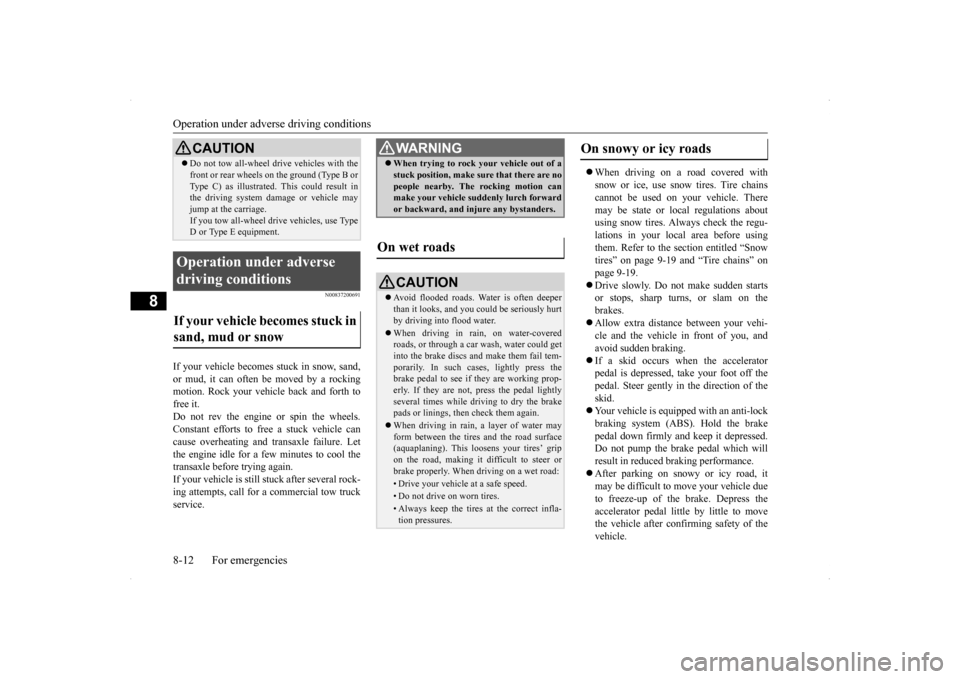
Operation under adverse driving conditions 8-12 For emergencies
8
N00837200691
If your vehicle becomes stuck in snow, sand, or mud, it can often be
moved by a rocking
motion. Rock your vehicle back and forth tofree it. Do not rev the engine or spin the wheels. Constant efforts to free a stuck vehicle cancause overheating and transaxle failure. Let the engine idle for a few minutes to cool the transaxle before trying again.If your vehicle is still stuck after several rock- ing attempts, call for a commercial tow truck service.
When driving on a road covered with snow or ice, use snow tires. Tire chains cannot be used on your vehicle. Theremay be state or local regulations about using snow tires. Always check the regu- lations in your local area before usingthem. Refer to the section entitled “Snow tires” on page 9-19
and “Tire chains” on
page 9-19. Drive slowly. Do not make sudden starts or stops, sharp turns, or slam on the brakes. Allow extra distance between your vehi- cle and the vehicle in front of you, and avoid sudden braking. If a skid occurs when the accelerator pedal is depressed, take your foot off the pedal. Steer gently in the direction of the skid. Your vehicle is equipped with an anti-lock braking system (ABS). Hold the brake pedal down firmly and keep it depressed.Do not pump the brake pedal which will result in reduced braking performance. After parking on snowy or icy road, it may be difficult to move your vehicle due to freeze-up of the brake. Depress the accelerator pedal little by little to movethe vehicle after confirming safety of the vehicle.
Do not tow all-wheel dr
ive vehicles with the
front or rear wheels on the ground (Type B or Type C) as illustrated. This could result in the driving system damage or vehicle may jump at the carriage.If you tow all-wheel drive vehicles, use Type D or Type E equipment.
Operation under adverse driving conditions If your vehicle becomes stuck in sand, mud or snow
CAUTION
WA R N I N G When trying to rock your vehicle out of a stuck position, make sure that there are no people nearby. The rocking motion can make your vehicle suddenly lurch forward or backward, and injure any bystanders.
On wet roads
CAUTION Avoid flooded roads. Water is often deeper than it looks, and you could be seriously hurt by driving into flood water. When driving in rain, on water-covered roads, or through a car wash, water could getinto the brake discs and make them fail tem- porarily. In such cases, lightly press the brake pedal to see if they are working prop-erly. If they are not, press the pedal lightly several times while driving to dry the brake pads or linings, then check them again. When driving in rain, a layer of water may form between the tires and the road surface(aquaplaning). This loosens your tires’ grip on the road, making it difficult to steer or brake properly. When driving on a wet road:• Drive your vehicle at a safe speed.• Do not drive on worn tires.• Always keep the tires at the correct infla- tion pressures.
On snowy or icy roads
BK0200800US.bo
ok 12 ページ 2013年2月14日 木曜日 午後2時28分
Page 285 of 338

Tires 9-14 Vehicle care and maintenance
9
EXAMPLE: 95H
Maximum load indicates the maxi- mum load this tire is designed tocarry.
R
Construction code •“R” means radial construc- tion. •“D” means diagonal or biasconstruction.
15 Rim diameter in inches (in)
NOTE
European/Japanese metric tire sizing is based on European/Jap- anese design standards. Tiresdesigned to these standards have the tire size molded into the sidewall beginning with the sec-tion width. The letter “P” is absent from this tire size desig- nation. Example: 215/65R1596H.
LT (Light Truck) -metric tire sizing is based on U.S.A. design standards. The size designationfor LT-metric tires is the same as for P-metric tires except for the letters “LT” that are molded intothe sidewall preceding the size designation. Example: LT235/85R16.Temporary spare tires are highpressure compact sparesdesigned for temporary emer- gency use only. Tires designed to this standard have the letter“T” molded into the sidewall preceding the size designation. Example: T145/80D18 103M.
Service Description 95
Load index A numerical code associ-ated with the maximum load a tire can carry.
NOTE
H
Speed symbol A symbol indicating the range of speeds at which a tire can carry a load corre-sponding to its load index under certain operating con- ditions.The maximum speed corre- sponding to the speed sym- bol should only be achievedunder specified operating conditions. (i.e. tire pressure, vehicle loading, road condi-tions and posted speed lim- its)
Maximum Load
BK0200800US.bo
ok 14 ページ 2013年2月14日 木曜日 午後2時28分
Page 311 of 338
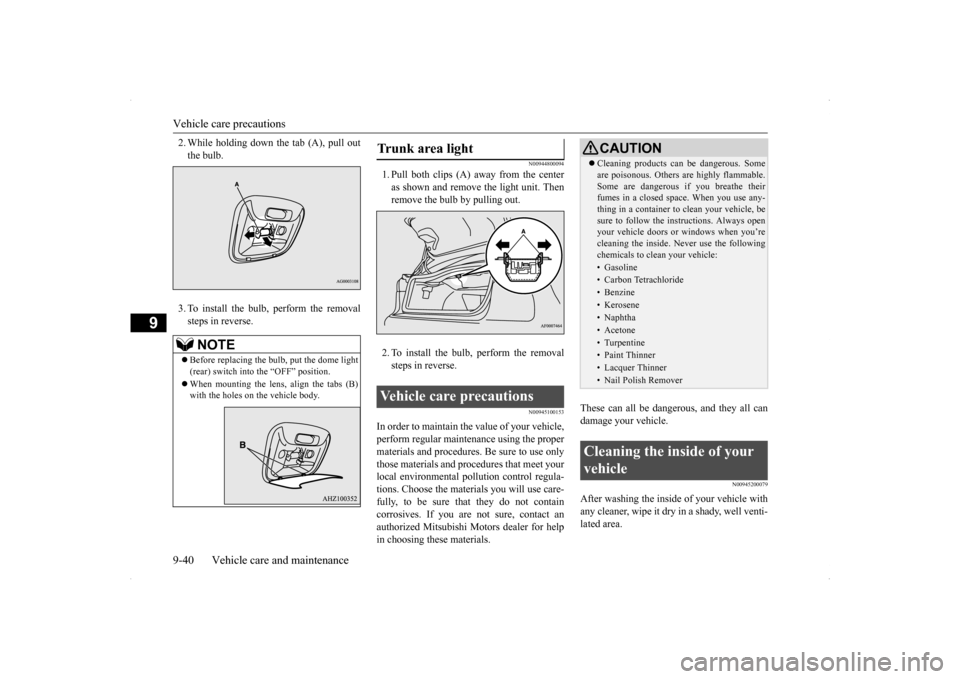
Vehicle care precautions 9-40 Vehicle care and maintenance
9
2. While holding down the tab (A), pull out the bulb. 3. To install the bulb, perform the removal steps in reverse.
N00944800094
1. Pull both clips (A) away from the centeras shown and remove the light unit. Thenremove the bulb by pulling out. 2. To install the bulb, perform the removal steps in reverse.
N00945100153
In order to maintain the value of your vehicle, perform regular maintenance using the proper materials and procedures. Be sure to use only those materials and procedures that meet yourlocal environmental pollution control regula- tions. Choose the materials you will use care- fully, to be sure that they do not containcorrosives. If you are not sure, contact an authorized Mitsubishi Motors dealer for help in choosing these materials.
These can all be dangerous, and they all can damage your vehicle.
N00945200079
After washing the inside of your vehicle withany cleaner, wipe it dry in a shady, well venti-lated area.
NOTE
Before replacing the bulb, put the dome light (rear) switch into the “OFF” position. When mounting the lens, align the tabs (B) with the holes on the vehicle body.
Trunk area light Vehicle care precautions
CAUTION Cleaning products can be dangerous. Some are poisonous. Others are highly flammable. Some are dangerous if you breathe their fumes in a closed space. When you use any- thing in a container to clean your vehicle, besure to follow the instructions. Always open your vehicle doors or windows when you’re cleaning the inside. Never use the followingchemicals to clean your vehicle:• Gasoline• Carbon Tetrachloride• Benzine• Kerosene• Naphtha• Acetone• Turpentine• Paint Thinner• Lacquer Thinner• Nail Polish Remover
Cleaning the inside of your vehicle
BK0200800US.bo
ok 40 ページ 2013年2月14日 木曜日 午後2時28分
Page 321 of 338
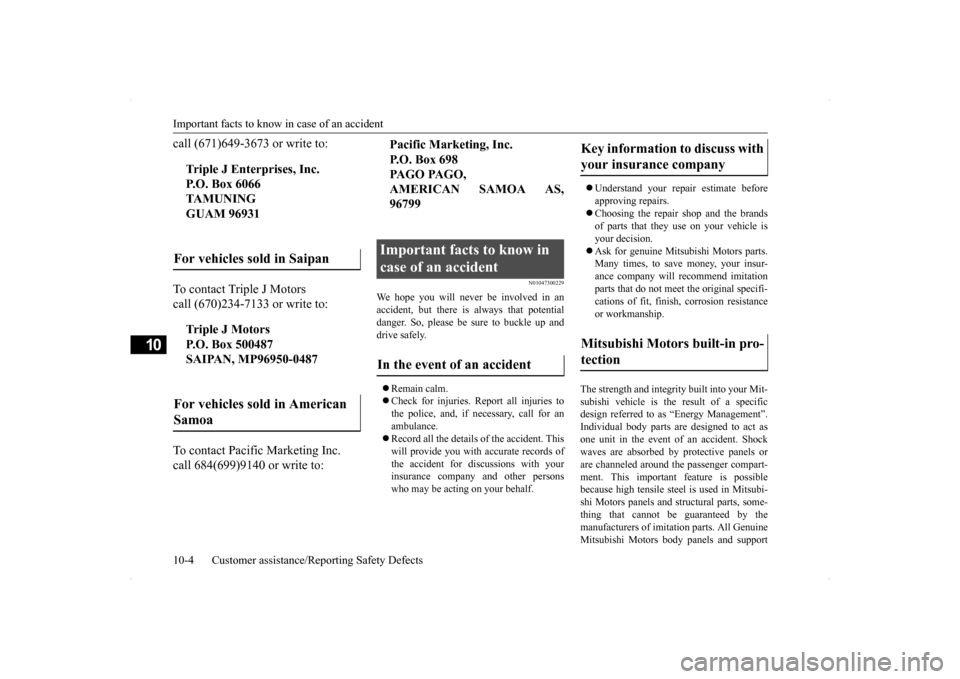
Important facts to know in case of an accident 10-4 Customer assistance/Reporting Safety Defects
10
call (671)649-3673 or write to: To contact Triple J Motors call (670)234-7133 or write to: To contact Pacific Marketing Inc. call 684(699)9140 or write to:
N01047300229
We hope you will never be involved in an accident, but there is always that potential danger. So, please be sure to buckle up and drive safely. Remain calm. Check for injuries. Report all injuries to the police, and, if necessary, call for anambulance. Record all the details of the accident. This will provide you with accurate records ofthe accident for discussions with your insurance company and other persons who may be acting on your behalf.
Understand your repair estimate before approving repairs. Choosing the repair shop and the brands of parts that they use on your vehicle is your decision. Ask for genuine Mitsubishi Motors parts. Many times, to save money, your insur- ance company will recommend imitationparts that do not meet the original specifi-cations of fit, finish, corrosion resistance or workmanship.
The strength and integrity built into your Mit- subishi vehicle is the result of a specificdesign referred to as “Energy Management”. Individual body parts are designed to act as one unit in the event of an accident. Shockwaves are absorbed by protective panels or are channeled around the passenger compart- ment. This important feature is possiblebecause high tensile steel is used in Mitsubi- shi Motors panels and structural parts, some- thing that cannot be guaranteed by themanufacturers of imitation parts. All Genuine Mitsubishi Motors body panels and support
Triple J Enterprises, Inc. P.O. Box 6066 TA M U N I N G GUAM 96931
For vehicles sold in Saipan
Triple J Motors P.O. Box 500487 SAIPAN, MP96950-0487
For vehicles sold in American Samoa
Pacific Marketing, Inc. P.O. Box 698PA G O PA G O , AMERICAN SAMOA AS, 96799Important facts to know in case of an accident In the event of an accident
Key information to discuss with your insurance company Mitsubishi Motors built-in pro- tection
BK0200800US.bo
ok 4 ページ 2013年2月14日 木曜日 午後2時28分